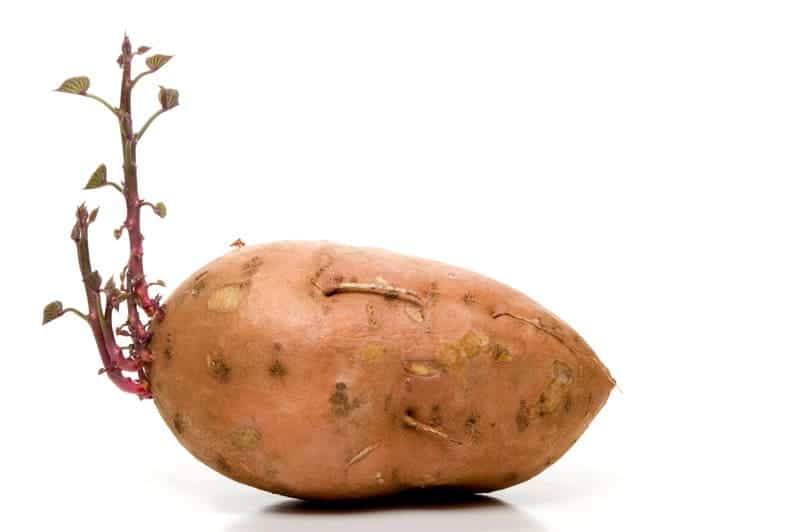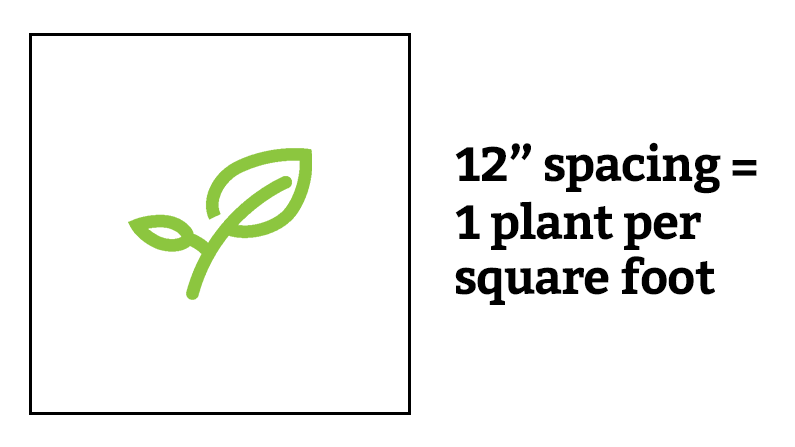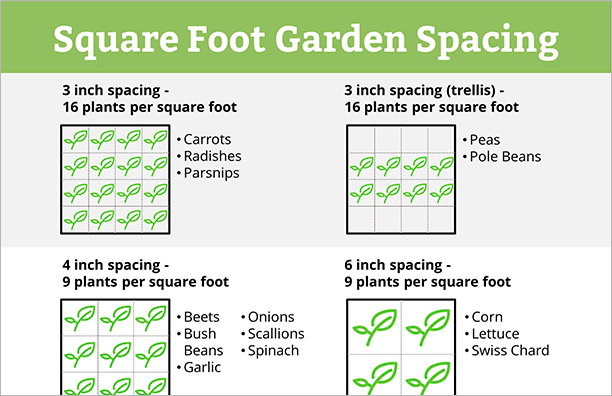How to Grow The Best Sweet Potatoes in a Square Foot Garden
Can I be honest?
I believe that few things are as yummy as sweet potato pie or sweet potato casserole topped with a layer of gooey, caramelized marshmallows.
And if you love sweet potatoes as much as I do, you may be wondering two things…
- Can I grow sweet potatoes in my square foot garden (or raised bed)?
- And can I grow them where I live?
I’m happy to tell you that the answer is yes to both!
Sweet potatoes do take a bit of prep work and need to be carefully harvested and cured.
But when you choose the right varieties and give them a little extra TLC, you can successfully grow sweet potatoes in your square foot vegetable garden, even in colder climates.
Keep reading to find out how!
Quick Tip: For the best possible results, download my free printable Square Foot Gardening Chart so you can quickly find the right spacing for over 20 vegetables.
Heads up: I’ll earn a small commission if you buy something after clicking a link in this post. I only link to products I’d recommend to my best friend.

How to grow sweet potatoes in a square foot garden.
Sweet potatoes are a large, rambling vine. (And growing them is very different than growing regular potatoes).
If this is your first time growing sweet potatoes, I recommend choosing a bush variety since the standard types can grow up to 16 feet long and swallow an entire vegetable garden!
If you want to grow the long vining types, you’ll need to decide what to do about the sweet potato vines.
- You can grow them up a tall trellis or fence or coax the vines to grow outside your garden bed if you have the room.
- Just know that they’ll try to take over.
Another option is to grow bush types in a large container or grow bag.
This way, you remove them from your garden entirely. If you do grow them in a container, plant the slips near the top of the container. See below for more details.
👉 Keep in mind that even the “compact” varieties will probably require trellising.
Related: New to square foot gardening? Learn more about square foot spacing.
Watch as MIGardener grows and harvests sweet potatoes:
Here are some of my favorite varieties:
Before you decide what sweet potato variety to grow, you should check with your local Cooperative Extension office (U.S. only) to see what varieties will grow well in your area.
👉 For gardeners who live in colder climates, you’ll need to make sure you have 100 frost-free growing days before trying to grow sweet potatoes.
- Bunch Port Rico is a compact variety that’s good for containers and small spaces.
- Vardaman is a bush variety that takes up less space (4-5′ vines) and produces large roots that are deep orange and tasty.
- Georgia Jet is a quick-maturing variety that is ready in 90-100 days.
If you want to grow the non-compact types, consider trellising the vines to save space.

Sweet potato growing tips and information.
Botanical name: Ipomoea batatas
Sweet potatoes are a member of the morning glory family.
Height: 1-2′ (and up to 16′ in length unless you grow a compact variety).
Sweet potatoes are perennial in tropical areas but are typically grown as a frost-tender annual.
Growing season: summer.
Time to harvest: After transplanting, you’ll harvest your first sweet potatoes in about 100 days.
Succession planting: Sweet potatoes are an excellent choice to follow early spring crops.
Companion planting: Not generally recommended for this large plant (it’ll swallow other plants whole!) And it prefers nitrogen-poor soil, whereas most vegetables need rich soil and more nutrients.
Sweet potatoes grow best when the days are hot and the nights are warm. They are very heat tolerant, but they can also survive a light frost as long as the soil temperature remains above 55° F.
Be sure to place your sweet potatoes in a spot where they won’t get shaded by a taller crop like tomatoes, corn, or pole beans. They need plenty of sunlight! 🌞🌞🌞
Pro tip: You’ll yield the best crop in nitrogen-poor soil. Too much nitrogen will cause them to produce long, thin tubers.
Sweet potatoes aren’t bothered by too many pests and diseases. The most common are aphids, hornworms, sweet potato weevils, and flea beetles (you can exclude many pests by using an insect barrier row cover).
If you decide to grow your sweet potatoes in pots or grow bags to save space, bury your slips 4-6 inches deep after filling your container to the top with potting soil.
FREE BONUS: Take the guesswork out of square foot gardening. Get my easy-to-use Square Foot Garden Spacing Chart now.
How to plant sweet potatoes in a square foot garden.
Plant your sweet potatoes in an area that gets full sun – at least 6 hours of sun per day. The more, the better!
Sweet potatoes are grown from “slips” – shoots from sweet potatoes that have rooted, typically in water.

Growing sweet potatoes from slips is a little like building a house.
It takes time.
And you have to follow a specific sequence of steps to turn the tuber on your counter into a thriving garden vegetable.
But it’s fun to watch the progress as you move from one stage to the next.
If you don’t want to start your slips, you can purchase them online or from a local nursery if you live in the Southern U.S.
How to grow sweet potato slips.
- Start your sweet potato slips indoors 30-40 days before your last frost.
- Get several sweet potatoes of a variety that will do well in your area.
- Cut each seed potato into sections and root them in a glass or jar of water. Suspend the potato in the water with toothpicks. It should make contact with the water so it can root but not be submerged.
- Place it in a sunny spot.
- Shoots will form.
- When they’re about 4-6 inches long, gently twist the shoots from the tuber.
- Put the shoots in a glass of water, immersing only the bottom half.
- Roots will grow in a few days.
- Once the roots are an inch or two long, they’re ready to plant.
Planting your sweet potato slips:
- Plant them soon after all danger of frost is past. Typically, that’s one to two weeks after your last frost.
- They’ll do best when planted in warm soil – preferably when the soil temperature is 60° to 85°F. (Here's my favorite thermometer for checking soil temperature).
- If you live in a short-season area, it’s a good idea to warm up your soil with an IRT or black plastic mulch around the time of your last frost. Here's my favorite plastic mulch .
- Plant your sweet potato slips 4-6″ deep.
- Bury them up to the top leaves and press the soil down gently.
- Water them well.
Could you use a FREE square foot spacing guide that’s easy to use even if you’re new to square foot gardening? Click here to get started!
Sweet potato spacing in a square foot garden.
Spacing for sweet potatoes in a square foot garden bed is one slip per square foot. I’d also suggest leaving a few adjacent squares empty if they’re going to share a bed with other plants. They need plenty of room!
Tired of searching for square foot garden spacing for each vegetable you want to grow? Download a FREE (and helpful) square foot gardening spacing chart now. And save hours of Googling!
1 plant per square foot

This plant spacing also works in a raised bed.
Once you know the proper spacing, it’s time to mark out your holes and transplant your slips.
You don’t need any special tools or equipment to set out your transplants. I use a couple of measuring tapes and a trowel to transplant each slip.
Harvesting sweet potatoes.
How do I know when sweet potatoes are ready to harvest?
It’s a question that crops up every fall.
You can tell sweet potatoes are ready to harvest when the leaves turn yellow. This signals that the roots are mature.
Harvest your sweet potatoes before the first fall frost (or right after the first frost if it takes you by surprise).
It’s best not to water them for two weeks before harvesting.
So, keep an eye on your sweet potatoes and cut back on the water when the leaves start turning, or two weeks before your last frost, whichever is earlier.
How to harvest sweet potatoes
Sweet potatoes have delicate skin, so be careful not to bruise them as you harvest.
To harvest them, use a garden fork to gently loosen the soil around the plant and carefully pry them up. Start as far away from the plant’s crown as you can and work your way toward the center.
After you harvest them, you need to cure them before cooking with them or storing them.
Curing and storing sweet potatoes
To cure your freshly harvested sweet potatoes, dry them in the shade for 2 to 3 hours.
Then move the roots to a place where the temperature will remain between 80° to 85° F for 10 to 14 days. You may need to find a spot like an upstairs closet where you can spread out the tubers and run a small space heater to keep the area warm enough.
It also helps to keep the humidity high while they cure. Pans of water could help, or run a small humidifier run a few times a day.
After they’ve cured, store your sweet potatoes in a cool, dark, dry place where the temperate remains between 55° and 60° F. They’ll last for several months. Check them periodically for wrinkling or soft spots. Toss out any that show signs of decay.
And be sure to save a few for next year’s slips!
Find the right spacing for your vegetables in 2 minutes. Snag your FREE Square Foot Garden Spacing Chart now.
How many sweet potatoes do you get from one plant?
Typically, you’ll be able to harvest 3-5 tubers per sweet potato plant, which is about 1-2 pounds. But if you live in a warmer climate, you may harvest six or more tubers per plant.
How long can sweet potatoes stay in the ground?
Harvest your sweet potatoes before the first fall frost. If you leave them in the ground too long, they may rot.
Will sweet potatoes come back next year?
They can live through the winter in USDA hardiness zones 9 to 11. So, if the roots survive the winter, they’ll regrow. But if you live in a zone colder than 9, you’ll need to either give them significant protection over the winter or plan to replant them every year. See how to start sweet potatoes from slips.
Can I grow sweet potatoes from a sweet potato?
Yes. It’s the only way to grow new sweet potatoes. Sweet potatoes are grown from a sweet potato slip. There are some specific steps you need to follow to get them ready for planting. Learn more about starting sweet potatoes from slips.
What month is best to plant sweet potatoes?
The best time to start sweet potatoes depends on where you live. They’re typically planted one to two weeks after your last frost. And it’s best to plant them when the soil temperature is 60° to 85°F.
Why are my sweet potatoes long and skinny?
Too much nitrogen causes long, thin sweet potato roots. Next season, don’t amend your soil or add anything that would increase the nitrogen levels like fertilizer, manure, or compost. And don’t fertilize your plants unless they appear unhealthy.
Download your free square foot gardening chart
It’s easy to always use the right spacing for your vegetables. Just download the Square Foot Gardening Chart and:
- Print it.
- Put it in a handy spot.
- Pull it out when you’re ready to plant seeds or transplants.
It really is that easy!
Here’s a sneak peek of your chart:

Your turn: Have you grown sweet potatoes in a square foot garden?
Have you used square foot spacing for your sweet potatoes before?
Tell me how it went! Share in a comment below.



I live on a city lot and have a small grow my own food. I decided to grow sweet potatoes in a square foot garden but had no idea how to do it. This was the perfect solution for me. The instructions are clear and easy to follow and the spacing chart is a really nice extra!
I’m so happy I found your guide and followed the tips and tricks. Now I am growing the most delicious, organic sweet potatoes I’ve ever eaten! I’ve been able to increase my yields, and am saving money.
Thanks for information on going sweet potatoes,Just need to get more information on keeping the pesty bugs out of my garden. Thanks again
I live in NE IN, zone 6a. I have grown sweet potatoes for several years. In late winter/early spring I fill a plastic shoe box 2/3 full with potting soil, placing my “too small to eat” tubers from last year on top of the soil, then add a little more potting soil to partially cover the tubers. Water regularly to keep soil damp, not wet. I put the box under lights. Heat mat helps, but not necessary. Also, if I find a sweet potato that is starting to produce shoots, I cut the sprouting end off, let it dry for a couple hours, then place it in damp potting soil, and cook the remaining potatoes for supper. There’s no need to waste a large whole sweet potato. I plant late May, harvest October/November. I have a very small garden, so I add a trellis and occasionally weave the vines through the trellis. My biggest potato was “as big as your head,” well over a pound, with about 6 smaller tubers in the same clump.
Hi Jolene,
Thanks for sharing your helpful tips!